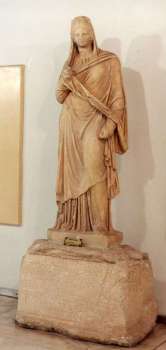Plancia Magna
 During excavations at Perge,
inscriptions and statues were found of Plancia Magna who added to the beautification of
the city by her patronage in the first half of the 2nd century A.D. Three statues and
numerous inscriptions have been discovered, and her tomb has been found just outside the
4th century later city gate. Inscriptions have also been found which give information
about the family of Plancia Magna. The inscribed bases of statues of M. Plancius Varus and
his son G. Plancius Varus were found in the Hellenistic courtyard of the entrance to the
city. From the inscriptions it is understood that they were wealthy and influential
citizens who held the title ktistes (founder) and had also made benefactions
which contributed to the prosperity of Perge. The inscriptions refer to father and son as father
and brother of Plancia Magna. The benefactions Plancia Magna made for the city
included restoration of the Hellenistic entrance of the city by embellishing the courtyard
with marble facing, decorative architectural elements and statuary. She also provided a
two-tiered triumphal arch which had three entrances and was decorated with statues.
Plancia Magna was honoured by the boule, demos and gerousia of
Perge as demiourgos, which is a title denoting the annual eponymous magistrate, a
high office reserved for men. She also held the titles of high-priestess of Pergaean
Artemis and high-priestess of the Imperial Cult. The statues of this example of one of the
most influential, successful and highly respected women of Anatolia are exhibited in the
Antalya Museum. During excavations at Perge,
inscriptions and statues were found of Plancia Magna who added to the beautification of
the city by her patronage in the first half of the 2nd century A.D. Three statues and
numerous inscriptions have been discovered, and her tomb has been found just outside the
4th century later city gate. Inscriptions have also been found which give information
about the family of Plancia Magna. The inscribed bases of statues of M. Plancius Varus and
his son G. Plancius Varus were found in the Hellenistic courtyard of the entrance to the
city. From the inscriptions it is understood that they were wealthy and influential
citizens who held the title ktistes (founder) and had also made benefactions
which contributed to the prosperity of Perge. The inscriptions refer to father and son as father
and brother of Plancia Magna. The benefactions Plancia Magna made for the city
included restoration of the Hellenistic entrance of the city by embellishing the courtyard
with marble facing, decorative architectural elements and statuary. She also provided a
two-tiered triumphal arch which had three entrances and was decorated with statues.
Plancia Magna was honoured by the boule, demos and gerousia of
Perge as demiourgos, which is a title denoting the annual eponymous magistrate, a
high office reserved for men. She also held the titles of high-priestess of Pergaean
Artemis and high-priestess of the Imperial Cult. The statues of this example of one of the
most influential, successful and highly respected women of Anatolia are exhibited in the
Antalya Museum.
- Source:
- 9000 Years of the Anatolian Woman
Istanbul 1993
By the Turkish Ministry of Culture
ISBN 975-17-1186-X
|